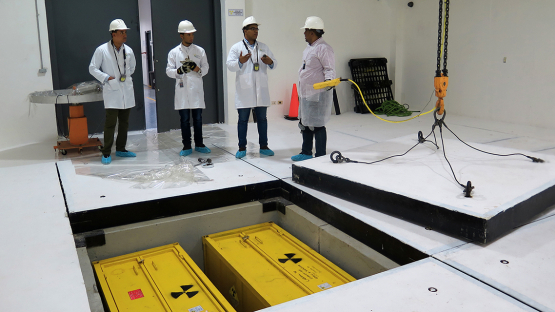As a growing number of countries use nuclear technology to generate electricity and radioactive material for many other purposes, there is significant progress in the safe and effective management of radioactive waste and spent nuclear fuel arising from these activities, including the development of deep geological repositories (DGRs), an IAEA report has found.
Status and Trends in Spent Fuel and Radioactive Waste Management provides an overview of options for managing spent fuel and radioactive waste, including information on national inventories, expected future waste and spent fuel arisings and strategies for their long-term management. The European Commission, the OECD Nuclear Energy Agency and the World Nuclear Association have contributed to the report.
“The successful management of radioactive waste and spent nuclear fuel underpins the peaceful use of nuclear technology in all its facets, from low-carbon energy production to medicine and industry,” said Mikhail Chudakov, IAEA Deputy Director General and Head of the Department of Nuclear Energy. “This publication not only provides analysis but also brings together all available relevant data, to help the international community keep abreast of the latest status and trends in this important field.”
The report makes a number of key points, such as:
- Many countries are taking major steps to dispose of all types of nuclear and radioactive waste, with more than 80% of all solid radioactive waste volume now in disposal.
- In terms of overall volume, around 95% of existing radioactive waste has very low level (VLLW) or low-level (LLW) radioactivity, while about 4% is intermediate level waste (ILW) and less than 1% is high-level waste (HLW).
- Since the start of nuclear electricity production in 1954 to the end of 2016, some 390,000 tonnes of spent fuel were generated. About two-thirds is in storage while the other third was reprocessed.
- The provision of funds/financing mechanisms to pay for decommissioning and radioactive waste disposal are well established in most countries. Several projects are underway to dispose of spent fuel and HLW.
- Recent years have shown steady engagement with the public during the process for selecting disposal sites.
A good understanding and forecast of the national radioactive waste and spent fuel inventory is essential for planning their safe and efficient management route. To support countries in this effort, the IAEA, in close cooperation with the European Commission and the OECD/NEA, in June 2020 launched a new database for spent fuel and radioactive waste, the Spent Fuel and Radioactive Waste Information System (SRIS). This tool further facilitates information sharing and simplifies national reporting in a single easy-to-use platform.
The report highlights internationally accepted technical solutions to manage spent fuel and radioactive waste safely and sustainably. Many industrial scale methods exist for safe processing, packaging, storage and disposal of ILW, LLW and VLLW. DGR projects for disposal of spent fuel and HLW are well under way. Finland is expected to start operating its DGR in the mid-2020s, while licensing or site selection for facilities are well advanced in Canada, France, Sweden and Switzerland.
Nevertheless, the prolonged storage periods for spent fuel caused by the current lack of disposal capacity or limited implementation of recycling have resulted in the need for additional storage capacity worldwide. Several countries are meeting this situation by building new storage facilities outside reactor buildings, either within or outside plant boundaries, or as a centralized national facility.
The report also highlights a wide range of research and development (R&D) dedicated to further improving the management of spent fuel and radioactive waste. The potential deployment of new reactor types and advanced fuel cycles may also affect waste management in countries that deploy such technologies. For example, a wider deployment of fast neutron reactors and associated closed fuel cycles could significantly reduce the volume and toxicity of spent fuel and high-level waste, thereby shrinking the required footprint of future DGRs. While R&D is promising in this area, it is too early to estimate the future benefits of such developments, the report notes.



